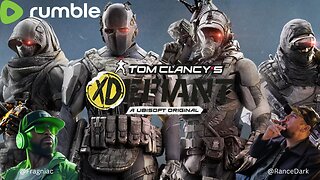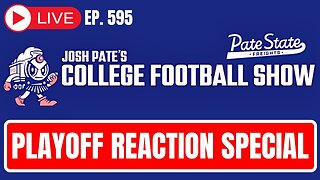Premium Only Content

Most spooky genre readers believe they can solve real-life mysteries
More than three in five spooky genre readers say they could solve a real-life mystery, according to a recent survey.
The survey of 2,000 horror, mystery, thriller and true crime readers found that 61% believe they have what it takes to unravel a real-world mystery plot.
But, only four in 10 (41%) are confident they’d survive the plot of a horror novel and live to tell the tale. Interestingly, men were significantly more confident in their survival skills compared to women (51% vs. 37%).
Conducted by Talker Research and commissioned by ThriftBooks, the research investigated all things related to the spooky genre: Plot-come-to-life scenarios, favorite spooky books and even safety best practices gleaned from reading the genre.
When asked which character stereotype they identify with, one in four (26%) identified as the sidekick character and 12% said they’d most likely be the victim in a scary book.
Unabashedly, more than one in 10 (13%) reported they’d be the villain and only 45% believe they have what it takes to be the hero or detective in a spooky book.
Looking closer at villains, this time in the real world, 68% said that they can tell if someone is a “bad” person simply by the vibes they give off. Women were more likely to report this compared to men (70% vs 61%).
And more than half of readers (51%) said someone in their everyday routine fits the mold of a villian from a spooky novel.
Looking at who actually matches the stereotype, the most common answer was a neighbor (44%). Shockingly (or maybe not) the second most common answer was a family member (31%).
Uncovering how reading scary books has made a lasting impact on respondents, 68% reported that they’ve adopted safer habits after reading the genre.
These include not sharing personal info with strangers (63%), not answering calls or texts from unfamiliar numbers (62%), not posting their location on social media (52%) and never posting any personal info on the internet (51%).
Readers said they feel a combination of sensations after reading a scary book such as feeling energized (29%), afraid (28%) and even wary of strangers (22%).
More than half (54%) also admitted they’re more easily startled after reading a scary novel. And it takes two days, on average, for these feelings to subside after reading a haunting book.
Thirty-three percent have slept with the lights on after a chilling read, 21% have checked under the bed and 20% have even refused to answer the door when the doorbell rang after finishing a spooky read.
“It’s interesting and so relatable to see all the things we’ve done after reading a scary book,” said Barbara Hagen, vice president of sales and marketing at ThriftBooks.
“Who hasn’t slept with the lights on after reading a terrifying book? It’s also interesting, even informative, to see what safety habits spooky readers pick up. The scary book genre is a lot at once: Chilling, energizing and enthralling. It’s no wonder it’s such a popular genre.”
Readers, on average, reported picking up their first hair-raising book at age 12. After that, 60% said they were immediately addicted to the genre.
And it turns out, younger generations are more easily addicted to the genre: More Gen Z (73%), millennials (76%) and even Gen X respondents (72%) said they were immediately hooked on scary books after reading their first one compared to baby boomer respondents (45%).
Popular gateway scary books, according to the survey, include “Carrie,” “Dracula,” “Frankenstein,” “Goosebumps,” “Nancy Drew,” and “Scary Stories to Tell in the Dark.”
When asked about their all-time favorite scary reads, readers cited books including: “Goosebumps,” “It,” “Pet Sematary,” “Silence of the Lambs,” “The Exorcist,” “The Shining” and “The Stand.”
It’s no surprise then that Stephen King (68%) was the most popular answer by a landslide, across all generations, when respondents were asked about their favorite horror authors.
“If you haven’t already this year, we encourage readers to pick up a scary book,” said Hagen. “Whether it’s a repeat read or a new one, there’s no better time of year to get into the genre.”
Survey methodology:
Talker Research surveyed 2,000 Americans who regularly read mystery, horror, thrillers/suspense or true crime books; the survey was commissioned by ThriftBooks and administered and conducted online by Talker Research between Sept. 17 and Sept. 23, 2024.
We are sourcing from a non-probability frame and the two main sources we use are:
● Traditional online access panels — where respondents opt-in to take part in online market research for an incentive
● Programmatic — where respondents are online and are given the option to take part in a survey to receive a virtual incentive usually related to the online activity they are engaging in
Those who did not fit the specified sample were terminated from the survey. As the survey is fielded, dynamic online sampling is used, adjusting targeting to achieve the quotas specified as part of the sampling plan.
Regardless of which sources a respondent came from, they were directed to an Online Survey, where the survey was conducted in English; a link to the questionnaire can be shared upon request. Respondents were awarded points for completing the survey. These points have a small cash-equivalent monetary value.
Cells are only reported on for analysis if they have a minimum of 80 respondents, and statistical significance is calculated at the 95% level. Data is not weighted, but quotas and other parameters are put in place to reach the desired sample.
Interviews are excluded from the final analysis if they failed quality-checking measures. This includes:
● Speeders: Respondents who complete the survey in a time that is quicker than one-third of the median length of interview are disqualified as speeders
● Open ends: All verbatim responses (full open-ended questions as well as other please specify options) are checked for inappropriate or irrelevant text
● Bots: Captcha is enabled on surveys, which allows the research team to identify and disqualify bots
● Duplicates: Survey software has “deduping” based on digital fingerprinting, which ensures nobody is allowed to take the survey more than once
It is worth noting that this survey was only available to individuals with internet access, and the results may not be generalizable to those without internet access.
-
 0:52
0:52
SWNS
3 days agoThese are the time-consuming tasks for holiday hosts
16 -
 6:46:07
6:46:07
Rance's Gaming Corner
8 hours agoTime for some RUMBLE FPS!! Get in here.. w/Fragniac
121K1 -
 1:30:48
1:30:48
Josh Pate's College Football Show
8 hours ago $0.41 earnedCFP Reaction Special | Early Quarterfinal Thoughts | Transfer Portal Intel | Fixing The Playoff
25.1K -
 23:55
23:55
CartierFamily
3 days agoElon & Vivek TRIGGER Congress as DOGE SHUTS DOWN Government
84.9K88 -
 5:43:44
5:43:44
Scammer Payback
2 days agoCalling Scammers Live
157K25 -
 18:38
18:38
VSiNLive
2 days agoProfessional Gambler Steve Fezzik LOVES this UNDERVALUED Point Spread!
124K17 -
 LIVE
LIVE
Right Side Broadcasting Network
10 days agoLIVE REPLAY: President Donald J. Trump Keynotes TPUSA’s AmFest 2024 Conference - 12/22/24
4,443 watching -
 4:31
4:31
CoachTY
1 day ago $27.15 earnedCOINBASE AND DESCI !!!!
164K11 -
 10:02
10:02
MichaelBisping
1 day agoBISPING: "Was FURY ROBBED?!" | Oleksandr Usyk vs Tyson Fury 2 INSTANT REACTION
94.7K13 -
 8:08
8:08
Guns & Gadgets 2nd Amendment News
2 days ago16 States Join Forces To Sue Firearm Manufacturers Out of Business - 1st Target = GLOCK
118K88